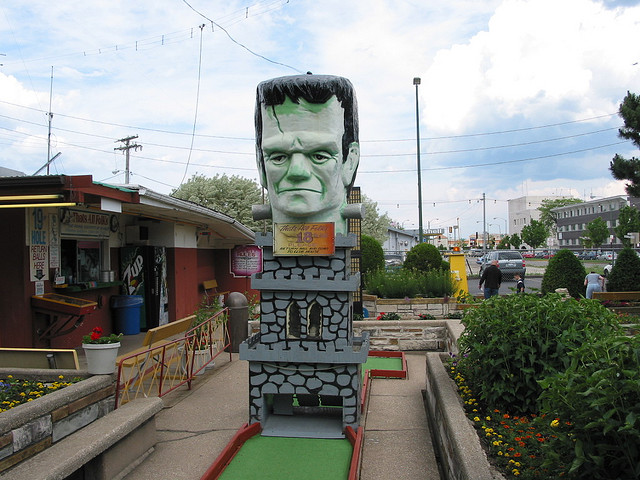Milton (Minky) Nimerov (born in 1915) was Shim's older brother who 'pushed' the name of "Minky's" on Shim claiming Minky's was a catchy name and would be easily remembered. Shim obviously thought so too. Besides bicycles, they sold sporting goods, hobby and crafts merchandise, toys, and were a Lionel train dealer.
 |
| Oil painting of Minky's Hobby & Sports Store at 3330-32 West Roosevelt Road, Chicago. Sent to me by Shim's Granddaughter, Denise Kase-Nabat. |
 |
| Minky's Hobby & Sports Store, 3330-32 West Roosevelt Road, Chicago, Illinois |
 |
| Left to right: Unknown, Minky, Shim, and brother Charley (who helped Minky run the Roosevelt Road store). |
 |
| Chicago Tribune, January 16, 1944. |
 |
| Minky's Bicycles, 2840 West Devon Avenue, Chicago, Illinois |
 |
| Chicago Tribune Ad, February 24, 1958. |
Bicycles were shipped in boxes and assembled at the dealerships. Many bike shops around the country had their own head badges and would replace the manufacturer's head badges with their own.

 |
| Chicago Tribune Ad, May 29, 1958. |
 |
| Proof to debunk that Minky owned the Minky's Bicycle shops. Shim thought 'Minky' had a memorable 'ring' to it. Eve Nimerov Obituary, Seymour's Wife. Chicago Tribune, October 6, 1997. |
Minky's Devon Avenue store was closed when Shim died in 1983. Seymour Nimerov is buried at Waldheim Cemetery in Forest Park, Illinois.
Milton Nimerov died 26 years after his brother Seymour. Wouldn't you think that if Minky really owned the Bicycle shop, it would have remained open for some time longer?
Copyright © 2020 Dr. Neil Gale, Ph.D. All rights reserved.
sidebar
Minky's son, David Nimerov has maliciously lied about his dad, Milton Nimerov, being the owner of Minky's and has done so for years, as he must have thought there was no proof of ownership still in existence.
After talking with Shim's family members, I did in-depth research to find out the truth.
During my written conversations with David Nimerov, he made these statements: "My Dad [Milton] Minky [Nimerov] was the owner. Shim was his younger brother and the salesperson." "There’s a reason the stores were named Minky’s Bicycles." "If I recall, my dad gave Eve (Shim's wife) $3,000 to walk away."
I don't know why he felt it necessary to propagate these lies for so many years. Perhaps just to be spiteful towards Shim's family. David's claiming Minky was the owner is like a person claiming to have served in the military but never did. "Stolen Valor!" A crime.
Both Seymour and Milton served honorably in WWII and I have a copy of both draft cards with service release stamps.
My Dad knew Shim and Minky from High School. We lived at Mozart and Arthur, one block north of Minky's on Devon. My Sister and I bought a lot more than we should have, of Matchbox Cars.
I ousted David to set the record straight. David is still lying and it's just plain wrong. It's hurtful to his own family that I had personal contact with. In Yiddish, David is a Schmuck!Seymour Nimerov's immediate family preapproved and condoned the information I wrote in the above note before I made this article public.













































